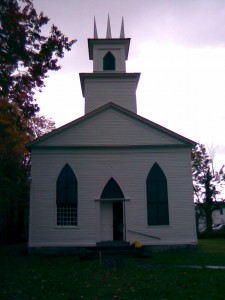Also called “Windsor Mills Christ Church Episcopal”
National Register of Historical Places
__________________________________________________
Brief History of Christ Church
Windsor Mills, Ashtabula County, Ohio
In 1816, the first Episcopal Church in Windsor was build by Solomon Griswold, a pioneer settler who came with his family to Windsor from Connecticut in 1800. Dubbed “Solomon’s Temple”, the edifice served the pioneer worshippers until 1832 when they purchased three acres of land from Alexander Alderman for $10.00.
The parcel of land was on the northeast corner of the crossroads later known as Windsor Mills. The church building constructed by those Connecticut settlers is shaped like a New England Meeting House, with curved supporting beams for the roof, pointed Gothic windows, pews of solid walnut, a balcony and a raised pulpit.
Sanctuary pews which seat 200 are divided in the center by a panel. Only one pew has a continuous aisle to allow passage from one side to another. The balcony has a seating capacity of 50, and access to it is gained by curving stairways on either side of the vestibule. A closet-like enclosure leads up awkward steps to the attic.
On Tuesday, October 1, 1833, the building was consecrated by Bishop McIlvane who described it as standing at “the edge of the forest”.
If early history of the body of believers at Christ Church was any indication the church would not last long. Soon after the church became established, “the parish was disrupted by a disastrous revival of the Campbellites (Disciples of Christ) in 1833-1834, which depleted the congregation and it lapsed into a quiescent state.” (source: unknown) By 1856, the church was abandoned. Its name was no longer included in a list of Ohio parishes in 1884, and 7 years later, “Grace Church, Windsor,” was declared extinct. It was the error in name that saved the historic church.
Early in the 1900s, Archbishop Asa Appleton Abbott reportedly “spent many days in a corner of the church where he had fitted up for himself a bed. He repaired the dilapidated church and revived the parish that had been virtually dead for 30 years.”1
The revival was brief. By 1920, the church again fell into disuse. Old-timers in Windsor recall the annual services conducted by the Episcopal Diocese of Cleveland in the church now abandoned. It may have been at one of these services that members of he Ashtabula County Historical Society became aware of the building ad its value to the history of the area.
In 1955, the Society obtained a twenty-year lease from the Episcopal Diocese of Cleveland at an annual rate of dollar. Restoration began in the summer of 1956. Dr. John Talcott of Jefferson spearheaded the project. He was able to obtain material from other buildings being razed and brought the project to completion far under the expected cost. A 30 x 18 addition was mad at the rear of the church to serve as a museum to house historic items from the area that the Society had acquired.
When the 20-year lease expired, the Ashtabula County Historical Society did not renew the lease. However, concerned area residents had anticipated the decision and had formed the Windsor Historical Society and they decided to gather the funds and obtain another 20-year lease form the Diocese.
In 2004, the Diocese sold the building to the Windsor Historical Society for $15,000. With a $5,000 down payment, the Society had ten years to pay off the remaining balance.
In 2008, the Society obtained a $25,000 grant from the Ashtabula Foundation for extensive repairs to the church “at the edge of the forest”; the forest now long gone.

